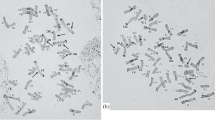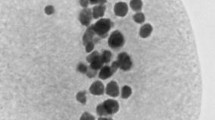Summary
Meiosis in F1-hybridHelianthus tuberosus (n=51) xH. annuus (n=17) was studied. At least five inversions were determined with certainty. The genom formula ofH. tuberosus should be At1At2Bt/At1At2Bt and that ofH. annuus-Ba/Ba. Genom formula of F1-hybrid is At1Bt/At2Ba, the chromosomes of Ba-genom conjugating with those of Bt-genom, while the other chromosomes of the other two genoms (At1 and At2) conjugating autosyndetically.
Cytogenetic indices for producing plants combining characters ofH. tuberosus andH. annuus are discussed.
Similar content being viewed by others
Literature
Bauer, H., 1936. “Beiträge zur vergleichenden Morphologie der Speicheldrüsenchromosomen.” — Zool. Jahtb., 56: 239–276.
Cockerell, D. A., 1929. “Hybrid sunflowers.” — Amer. Natur., 63: 470–475.
Dubinin, N. P., Sokolov, N. N. andG. G. Tiniakov, 1936. “Occurrence and distribution of chromosome aberration in nature (Diptera).” —Nature, June, pp. 1035–36.
Kostoff, Dontcho, 1930. “Ontogeny, genetics and cytology ofNicotiana hybrids.” — Genetica 12: 33–139.
Kostoff, Dontcho, 1934. “A contribution to the meiosis ofHelianthus tuberosus L.” — Zeitschr. f. Pflanzenzücht., 19: 429–438.
Kostoff, Dontcho, 1938. “Studies on polyploid plants XXI. Cytogenetic behaviour of the allopolyploid hybridsNicotiana glauca Grah. xNicotiana Langsdorffii Weinm. and their evolutionary significance.” Journ. Genet. 37: 129–209.
Kostoff, Dontcho, 1938b. “Directed hereditable variations conditioned by euploid chromosome alterations in higher plants” — Nature (London) 142 (3608): 1117–1118.
Makowetzky, M., 1929. “Karyologische Untersuchung vonHelianthus, tuberosus, H. annuus undCychorium Intybus.” (Ukrainian with Germ. summary) — Journ. Agr. Bot., Harkiv, 2: 211.
Müntzing, Arne, 1936. “The evolutionary significance of autopolyploidy.” — Hereditas (Lund), 21: 263–378.
Prozina, M. N., 1925. “Recherches caryologiques sur le turnesol. Division somatique chezHelianthus annuus.” — Jour. Russ. Bot. Soc., 9: 63–68.
Shchibrya, N. A., 1936. “Interspecific hybridization between Jerusalem artichoke (Helianthus tuberosus L.) and sunflower (Helianthus annuus L.)” — Compt. Rend. Acad. Sci., Moscow, Vol. II, No. 5 (91).
Schhibrya, N. A., 1938. “Interspecific hybridization in the genusHelianthus L.” — Bull. Acad. Sci., Moscow, Ser. Biol., No. 3, pp. 732–769.
Shevchenko, Z. D., 1937. “Meiosis in the F1-hybrids ofHelianthus divaricatus L. xHelianthus rigidus Desf.” — Cytogen. of cultiv. plants, pp. 61–71.
Tahara, M., 1915. “Cytological investigations on the root tips ofHelianthus annuus with special reference to the behaviour of the nucleolus.” —Bot. Magaz., Tokyo, 29: 1–5.
Wagner, S., 1932. “Artkreuzungen in der GattungHelianthus.” — Zeitsch. f. ind. Abst. Vererbungsl., 61:76–146.
Rights and permissions
About this article
Cite this article
Kostoff, D. Autosyndesis and structural hybridity in F1-hybrid Helianthus tuberosus L. x Helianthus annuus L. and their sequences. Genetica 21, 285–300 (1939). https://doi.org/10.1007/BF01508121
Received:
Issue Date:
DOI: https://doi.org/10.1007/BF01508121




